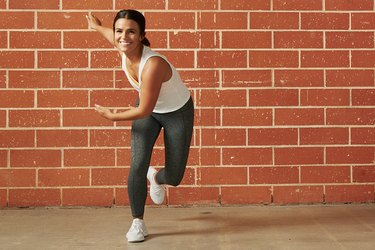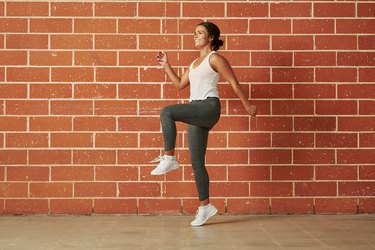
If you're trying to get fit but don't have a lot of time to devote to working out, the Tabata protocol might be the workout for you. Tabata is a four-minute, high-intensity interval training (HIIT) workout named after Izumi Tabata, PhD that involves a mix of 20 seconds of maximum effort followed by 10 seconds periods of rest for eight rounds.
"It's a tough training method if you do it correctly, but if you are doing eight rounds of the 20-10 formula and not truly pushing beyond max, you won't see the benefits of the authentic Tabata format," exercise physiologist Michele Olson, PhD, tells LIVESTRONG.com. She notes that getting to that max level every time may mean you need to stick with only five to six rounds in the beginning and build up to eight full rounds. It's best to cut your rounds short and go all out, otherwise you're just doing a variation of circuit training.
Video of the Day
Video of the Day
1. High Knees

Before you jump into this workout, Olson recommends a five-minute warm-up. Jumping rope — real or imaginary — is a great way to break a pre-Tabata sweat. After you've warmed up, you'll be ready for your first interval: high knees.
- Start by running in place as fast as you can — remember to go all out!
- Drive your knees up as high as you can lift them, pumping your arms back and forth to help propel your knees higher for 20 seconds.
- Rest for 10 seconds and then move right into the next exercise.
2. Squat Jump
The squat jump is a great plyometric exercise that targets all the major muscle groups of your lower body while getting your heart rate skyrocketing.
- Lower into a squat position, pushing your hips back and knees tracking over (but not past) your toes.
- Keep your chest lifted and arms bent with your elbows touching your knees.
- Quickly jump straight up, reaching your arms overhead.
- Land softly in squat position and then immediately repeat for 20 seconds.
- Rest for 10 seconds and then repeat once more.
3. Dumbbell Snatch
As a traditional kettlebell training exercise, this move challenges your entire body while building incredible core stability. If you don't have a kettlebell, Olson recommends using an eight- to 10-pound dumbbell, depending on your fitness level.
- Stand with your feet slightly wider than shoulder-width apart. Holding a dumbbell with your left hand, extend your right arm out straight to the side of your shoulder.
- Lower into a squat position as you swing the dumbbell through your legs.
- Explode through your hips to stand up and press the dumbbell vigorously overhead.
- Repeat as quickly as possible with good form for a total of 20 seconds.
- Rest for 10 seconds and then repeat on the opposite side.
4. Speed Skater
Channel your inner Olympic speed skater for this one and focus on stability and balance.
- Stand with your feet together and your arms by your sides.
- Take a wide step out to the side with your left foot, lowering into a squat position.
- Bend your right knee behind your body, tapping your right foot lightly on the floor and swinging your arms to the left.
- Quickly push off your left leg, swinging your arms out to the sides of your shoulders as you jump out and over to the right.
- Land on your right leg with your left leg crossed back, arms swinging to the right side.
- Repeat as quickly as possible for 20 seconds.
- Rest for 10 seconds and then move right into the next interval.
5. Lunge Jump
Here's another plyometric exercise that targets your lower body. But this time, instead of squats, you're jumping from a lunge position.
- Step with your right leg back into a lunge, bending your elbows with your arms by your sides.
- Jump straight up, reaching your arms overhead and extending your legs.
- Land softly in the lunge position with the same leg in front.
- Repeat as quickly as possible for 20 seconds.
- Rest for 10 seconds and then repeat on the opposite side.